This article first appeared in Document 15
Oct 16, 2015. It is the second year we’ve organised a public debate as a highlight of the Design Manchester festival – and once again, our panel underscored Manchester’s place at the heart of the nation’s cultural discourse.
View the debate here.
Set in the redesigned Whitworth, Design Manchester’s Great Debate welcomed a panel discussion to explore how design contributes to the city, the economy and society – whether through culture, architecture, media, fashion or leading edge technology.
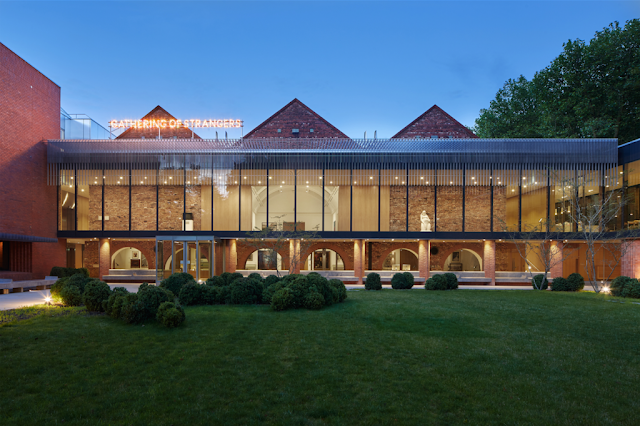
The Whitworth
The debate was chaired by RSA chief executive Matthew Taylor and the panel comprised Manchester City Council’s head of City Policy Jessica Bowles, the head of the Policy Lab at the Cabinet Office Dr Andrea Siodmok, the founder of magneticNorth Lou Cordwell and Design Council chief John Mathers. Once again the audience was equally qualified, with representatives of the government digital service, the universities, Manchester Science Park and the Knowledge Transfer Network alongside designers, architects, filmmakers, artists and creative businesses from Manchester and elsewhere.
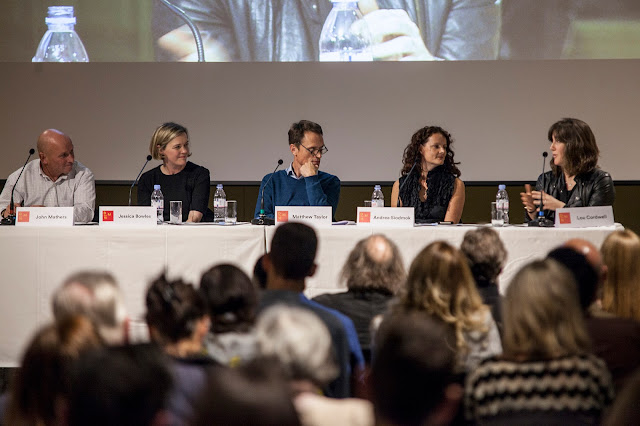
Left to right: John Mathers, Jessica Bowles, Matthew Taylor, Andrea Siodmok, Lou Cordwell
If last year’s subject (the then new-fangled northern powerhouse) was topical, this year’s – ‘the Values of Design’ – was eternal. What values do we express as individuals and as a society in what we produce? What contribution do we make as designers to the world in which we live? What role does design have in the economy? What is ‘Manchester’ about the design of our city and our services?
What’s it worth?
The big question of whether the economic value of design is more important than its social value – put by SharpFutures’ Tom Clarke – met unsurprisingly with a consensus among panel and audience that both are crucial. On the economic front, John Mathers pointed out that design now adds £72 billion a year to the UK economy and is growing rapidly in Manchester and the north west. Design has a key role if the government is to meet its targets for economic growth and jobs in the region in the coming decade. You cannot ignore the economics, Andrea Siodmok agreed, quoting the great Raymond Loewy’s observation that “the most beautiful curve in the world is an upward sales graph”. However, to the economic and social considerations, she would add a third: the environment. “We should look at design as a driver of value and its impact in terms of circularity.”
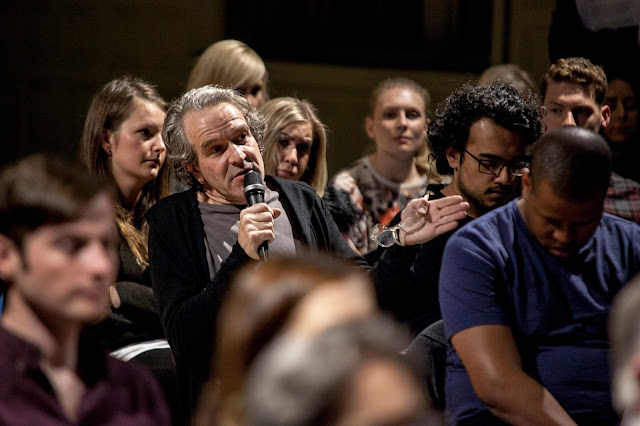
Dominic Sagar advocates creative solutions to social challenges
If we’re talking about the contribution of design, whether social or economic, Lou Cordwell pointed out, we have to remember its horizontal, cross-sector function. Design has its own sector but design thinking contributes in almost all other areas too. What does it mean for Manchester? The architect Dominic Sagar – one of the founders of the Northern Quarter Association and now a senior lecturer at Manchester School of Architecture – appealed for creativity and a radical approach to solving social problems. Investment in the city is welcome, but “we don’t want to become Brandchester or Blandchester and have our spirit squashed”.
No danger of that, parried Jessica Bowles. For one thing, we must avoid growing inequality as it undermines the city’s economic and social health. “Manchester has a radical and progressive history and a radical and progressive future,” she said. For another, distinctiveness is at the heart of how mid-size cities need to build a long-term future, creating an interesting place where people want to live, stay, visit and invest. “That sense of a vibrant, buzzy, exciting city is fuelled by designers and great design.”
Growing local talent
With all the planned investment in the new Factory cultural centre and The Corridor, Carol Isherwood of Shoosmiths wondered, should we favour Manchester-based architects over global superstars?
Manchester is a world-class city that can and does collaborate with the best talents in the world, but there is a case, Lou Cordwell thought, for using this window of opportunity to stimulate local talent at all development stages and show that “if you want to make your name and be world-class in your field, this city is the place you can do it.”
The architecture competitions, Jessica Bowles agreed, are just one element of a much bigger range of design, development and delivery stages. Encouraging local talent was a key feature of the Town Hall extension and Central Library redevelopment, with 100 local apprentices acquiring high-grade craft skills working in listed buildings.
The health of the region
Devolution of the health budget is one of the most tangible outcomes to date of the Northern Powerhouse deal between the Greater Manchester authorities and the government. But with a rapidly ageing population and a £2 billion shortfall in the budget, asked Adapt Studios’ Andy Kayley, can we rise to the challenge?
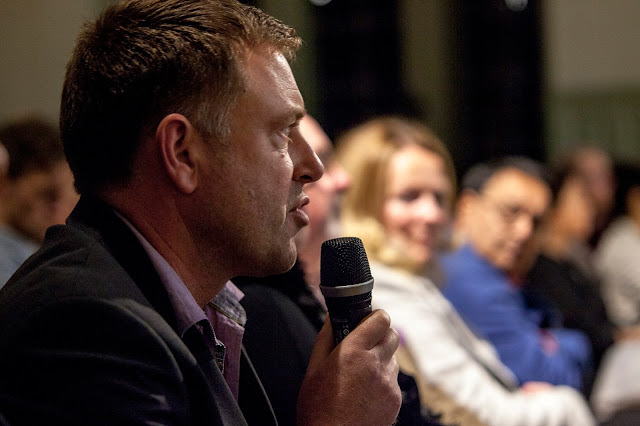
Adapt Studios’ Andy Kayley
The simple truth is that if we don’t do something different in health and social care we are going to be bust, was Jessica Bowles’ blunt response. “We need to drive innovation into practice at scale in health and social care settings.” The city is looking at creating the best development environment for trying new ideas and at how to incentivise best thinking and best practice. “We have the opportunity to join things up in a different way to get the creativity and break down the intersections between different silos.”
The unanimous view was that radical solutions are called for and design is fundamental to that. “How can we design better ways that we the public can organise our lives to support a smaller, transformed public service?” was Andrea Siodmok’s take. Patient hotels in Sweden encourage families into the health and care environment in ways our hospitals are not designed to do. We need a wider shift in the way health and care is given that calls more upon citizens.
Taking control “back into our own hands” is what is needed, agreed John Mathers – using fundamental design principles of understanding and listening to the users, and then helping them develop scaleable solutions.
The art of education
This debate was an opportunity to make the voice of the design community heard in Manchester City Council’s consultation about its draft strategy for the next ten years – not least in the field of education and skills. “It is important,” that draft states, “that children and young people growing up in Manchester aspire to be part of the city’s success” – and the first measure of that success listed in the skills section would be to “improve educational attainment to be above the national average at every key stage with a focus on STEM [science, tech, engineering and maths] subjects.”
That approach was challenged by David Spendlove, who had sent in a question which pointed to the fall in student and trainee teacher numbers in design and technology, criticising the government’s marginalisation of design and creative subjects. “How,” he demanded, “can we resuscitate and reinvigorate the presence of design in education and skills at all stages?”

Dame Nancy Rothwell
Professor Dame Nancy Rothwell, the vice-chancellor of Manchester University and chair of The Corridor, offered an unequivocal response by videolink: “Culture and arts,” she emphasised, “are just as important to us as the STEM subjects and will play an increasingly important part in the future of The Corridor.”
One problem, Lou Cordwell pointed out, is that many parents are unfamiliar with the rapidly changing nature of careers in design. ‘User experience’, for example, is a new notion they may find hard to support as a career choice, so people need to be exposed to the next generation of design careers. It’s important, agreed John Mathers, that design is seen as a valuable and sensible alternative. “It’s a real driver of growth in the UK, it adds real value and it is a very sensible alternative to STEM subjects.” More than that, design thinking should be taught to everyone as an alternative way of coming at solutions.
The future of design
Now that we live in a world where technology enables everyone to publish, record music, broadcast and design, what, wondered Alison Buckley of the Knowledge Transfer Network, is the changing role of designers in the future?
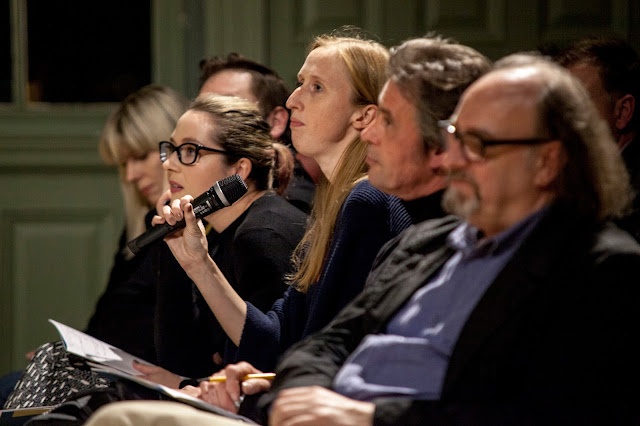
Left to right: Pentagram Associate Partner Jane Plüer, Adapt for Arts’ Steph Graham, Alison Buckley, Professor David Crow and Malcolm Garrett
Lou Cordwell pointed to the growing role of design in organisations, with some of the biggest companies such as Apple and Google placing design at the heart of their approach. “I hope the future role of design is to set the vision and the ambitions of companies and organisations.” The faster the world changes, the more we need design, agreed Andrea Siodmok. “The hallmark of design is that it responds to new challenges and problems. It moves at an incredible pace and as a designer, you’re only as good as what you learned last week.
Interdisciplinarity is another area where design can make the difference, added John Mathers. “Design can convene different skills and practices in a way few other practices can do as well, because it is about solving problems.” This is what sets designers apart from policymakers, Matthew Taylor observed: “Policymakers hate it when something goes wrong but designers quite like it, because it’s an opportunity to learn and do things differently.”
Jessica Bowles agreed that a design-led approach can bring the changes that are needed to improve public services. “Traditional project management processes with predetermined outcomes are so ingrained in what public services do, but very often this does not deliver great outcomes,” she pointed out. But while a design-led approach has great merit, she sounded a note of caution: “Don’t underestimate the challenge of making that happen within organisations!”
Creative Europe
The spectre of the EU referendum was raised by Clive Grinyer, who asked what the impact would be on the creative industries if we pull out.
Apart from a diplomatic civil servant neutrality observed by Andrea Siodmok, there was a clear consensus on this issue among the panel – and overwhelmingly the audience too, in a show of hands taken by Matthew. “The city would be poorer not being part of Europe,” Jessica Bowles stated unequivocally. The ability to welcome more people to live, work and experience time in Manchester creates an important ferment.
If we think Britain’s ahead of the game, we’ve got quite a shock coming, added John Mathers. We’d be poorer “because of what we can learn in ways we don’t even realise, by sharing and participating in what’s going on.” To Lou Cordwell, the idea that closing our borders would be a good thing for the creative process is alien. “Design and creativity is about new experience, open minds and wanting to be exposed to new people and new ways of thinking.”
Science and design
In 2016, Manchester is the European City of Science. What, Malcolm Garrett wondered, could this mean for design and the creative industries in the region?
One thing Lou Cordwell is keenly aware of as chair of the Manchester City of Science marketing group, is that the thousands of journalists and others coming to the events in Manchester next year are not just interested in science. They want to see football games, amazing buildings and the culture of the city. It is best to recognise that people have a broad palette. “I hope they come away not just with an awareness of Manchester and science, but also of Manchester and great design.”
In practical terms design has much to offer the world of science, added John Mathers, pointing to the unlocked IP potential in universities. “If you take design thinking and translate some of those ideas, there are huge opportunities.”
The voice of design
The debate rounded off with the question of how we can make sure the value of design is better understood by the public and policymakers. It was initiated by the Dean of Manchester School of Art, Professor David Crow, who picked up on a recurring theme of the evening: the cross-silo nature of design.
The wider question, Andrea Siodmok thought, is how good design decisions are made. Quoting Angela Dumas’ observation that 90% of design decisions are not made by designers, she reminded us that “like it or not, policymakers are making design decisions every single day.” But, said Lou Cordwell, it’s true there is a misunderstanding of what design is in the modern day at all levels, “whether you’re a 16-year old considering your career or a 40-year old running a company.” It’s a gap we won’t bridge just by talking to ourselves, Jessica Bowles pointed out. “How do you connect up with other interests and bring design out of your own discussions? It is through those cross-sectoral discussions that you get real traction.”
And that is of great importance in a city whose population expanded 20% in the first decade of the century and is continuing to grow rapidly. Design matters not just in the physical environment but in how we live, to create equity and avoid polarisation.

The debate continued afterwards over drinks in the South Gallery. L-R: Malcolm Garrett, festival director Fiona McGarva, Professor David Crow and Ben Terrett.
Debate photos © Sebastian Matthes except Nancy Rothwell © Kasper de Graaf

